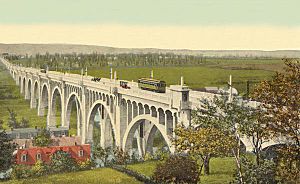Albertus L. Meyers Bridge facts for kids
Quick facts for kids Albertus L. Meyers Bridge |
|
|---|---|

Postcard (dated 1916) depicting Allentown's Eighth Street Bridge.
|
|
| Coordinates | 40°35′47″N 75°28′16″W / 40.5963°N 75.4712°W |
| Carries | Two lanes northbound and one lane southbound of 8th Street, from Union Street to Lehigh Street, and 2 sidewalks |
| Crosses | Little Lehigh Creek, Harrison Street and Martin Luther King, Jr. Drive |
| Locale | Allentown, Pennsylvania |
| Official name | Albertus L. Meyers Bridge |
| Named for | Albertus L. Meyers |
| Maintained by | City of Allentown |
| Characteristics | |
| Design | Reinforced concrete open-spandrel arch |
| Total length | 2,650 feet (810 m) |
| Width | 45 feet (13.72 m) (deck width) |
| Height | 138 feet (42 m) |
| Longest span | nine 120-foot (36.58 m) broad arches |
| History | |
| Opened | November 17, 1913 |
| Statistics | |
| Daily traffic | 14618 |
| Toll | Free |
| MPS | Highway Bridges Owned by the Commonwealth of Pennsylvania, Department of Transportation TR |
| NRHP reference No. | 88000870 |
| Added to NRHP | June 22, 1988 |
The Albertus L. Meyers Bridge (also known as the Eighth Street Bridge, the South Eighth Street Viaduct and unsigned as SR 2055) is a reinforced concrete open-spandrel arch bridge located in Allentown, Pennsylvania, in the United States. The bridge is "one of the earliest surviving examples of monumental, reinforced concrete construction."
When opened for traffic on November 17, 1913, the Albertus L. Meyers Bridge, then known as the Eighth Street Bridge, was the longest and highest concrete bridge in the world.
The bridge spans the Little Lehigh Creek, linking Allentown's center city with the city's South Side. The bridge has seventeen spans and is longer than the more massive Tunkhannock Viaduct of the same type.
History
The Lehigh Valley Transit Company organized the Allentown Bridge Company in 1911 for the sole purpose of "erecting, constructing and maintaining a bridge and approaches thereto over the Little Lehigh Creek." The bridge was designed by the engineering firm of B.H. Davis and built by McArthur Brothers of New York City. Costing in excess of $500,000, construction of the bridge, which lasted from July 1, 1912 to November 17, 1913, required 29,500 cubic yards (22,600 m3) of concrete and 1,100,000 pounds (500,000 kg) of metal reinforcing rods. The bridge spans the Little Lehigh Creek valley for a total length of 2,600'-0". It is an average of 38'-0" feet wide, with two 16-0" travel lanes and two sidewalks. The main structure spanning Little Lehigh Creek consists of nine open-spandrel concrete deck arch spans. There are eight closed-spandrel concrete deck arch approach spans.
The structure operated as a toll bridge from its November 17, 1913, opening until the 1950s, at which time the toll was five cents for an automobile.
The Liberty Bell Line, Lehigh Valley Transit's electric street car line that went to Quakertown, Sellersville, Lansdale, Norristown and Philadelphia ran across the bridge until that interurban service made its last run on the evening of September 6, 1951. On the final return trip from Norristown, in the early morning hours of September 7, car #1006 did not cross the bridge again but went directly to Fairview carbarn, located some distance southwest of the bridge. All rail operations across the bridge ended when the company ceased street trolley service in 1953. The concrete standards that once supported the trolley wire are still standing on the bridge to this day.
Formal naming
The Eighth Street Bridge was formally renamed the Albertus L. Meyers Bridge in 1974. Albertus L. Meyers was a well-known conductor of the Allentown Band and a cornet player in the band of John Philip Sousa. As a boy, Meyers played in the Allentown Band at the opening of this bridge that now bears his name.
The Albertus L. Meyers Bridge was added to the U.S. National Register of Historic Places on June 22, 1988.
Images for kids
-
Construction of Albertus L. Meyers Bridge in Allentown, 1912



